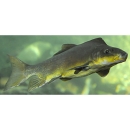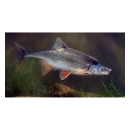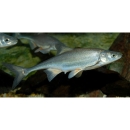Featured Species
Grand Junction FWCO works to recover populations of four endangered fish species that have inhabited the Colorado River Basin for millions of years, yet their populations have significantly diminished in a mere few decades. They are found no where else on earth an have evolved dynamic characteristics to deal with the varying environmental conditions that have occurred throughout history in the Colorado River.
Colorado Pikeminnow (Ptychocheilus lucius) - The Colorado pikeminnow is a big-river minnow found only in the Colorado River Basin. It was first listed as endangered in 1967 and was given full protection under the Endangered Species Act in 1973. Valued as food by early settlers and miners throughout the basin, wild populations now only occur in rivers upstream of Glen Canyon Dam, Arizona, and are stable or increasing. Individuals may reach 6 feet in length, weigh 80 pounds, and live 40 years. Known for long-distance spawning migrations of more than 200 miles in late spring and early summer, adults are capable of reproducing at 5 to 7 years of age. Young Colorado pikeminnow feed on insects and plankton, whereas adults feed mostly on fish. The species is being reintroduced into the San Juan and Verde rivers.
Razorback Sucker (Xyrauchen texanus) - The razorback sucker is a big-river fish found only in the Colorado River Basin. It was listed as endangered and given full protection under the Endangered Species Act in 1991. Valued as food by early settlers and miners, wild populations of razorback sucker are now extremely rare, declining, and consist primarily of adults. Poor survival of young has been attributed to loss of habitat and predation by nonnative fishes. Individuals may reach 36 inches in length, weigh 14 pounds, and live 40 years. Adults are capable of reproducing at 3 to 4 years of age, and spawning occurs during high spring flows. Razorback sucker feed on insects, plankton, and plant matter. The species is being reintroduced into the Green, Gunnison, upper Colorado and San Juan rivers, Lakes Mojave and Havasu, and the lower Colorado and Verde rivers.
Humpback chub (Gila cypha) - The humpback chub is an endangered, native fish of the Colorado River that evolved around 3-5 million years ago. The pronounced hump behind its head gives this fish a striking, unusual appearance. It has an olive-colored back, silver sides, a white belly, small eyes and a long snout that overhangs its jaw. Like the Colorado pikeminnow and bonytail, the humpback chub is a member of the minnow family.
Bonytail (Gila elegans) - The bonytail is the rarest of the endangered, native fish of the Colorado River and is thought to have evolved around 3-5 million years ago. It has large fins and a streamlined body that is pencil-thin near its tail. Its name describes the fish as an elegant swimmer and member of the “chub” group of minnows. The bonytail has a gray or olive-colored back, silver sides, and a white belly.






